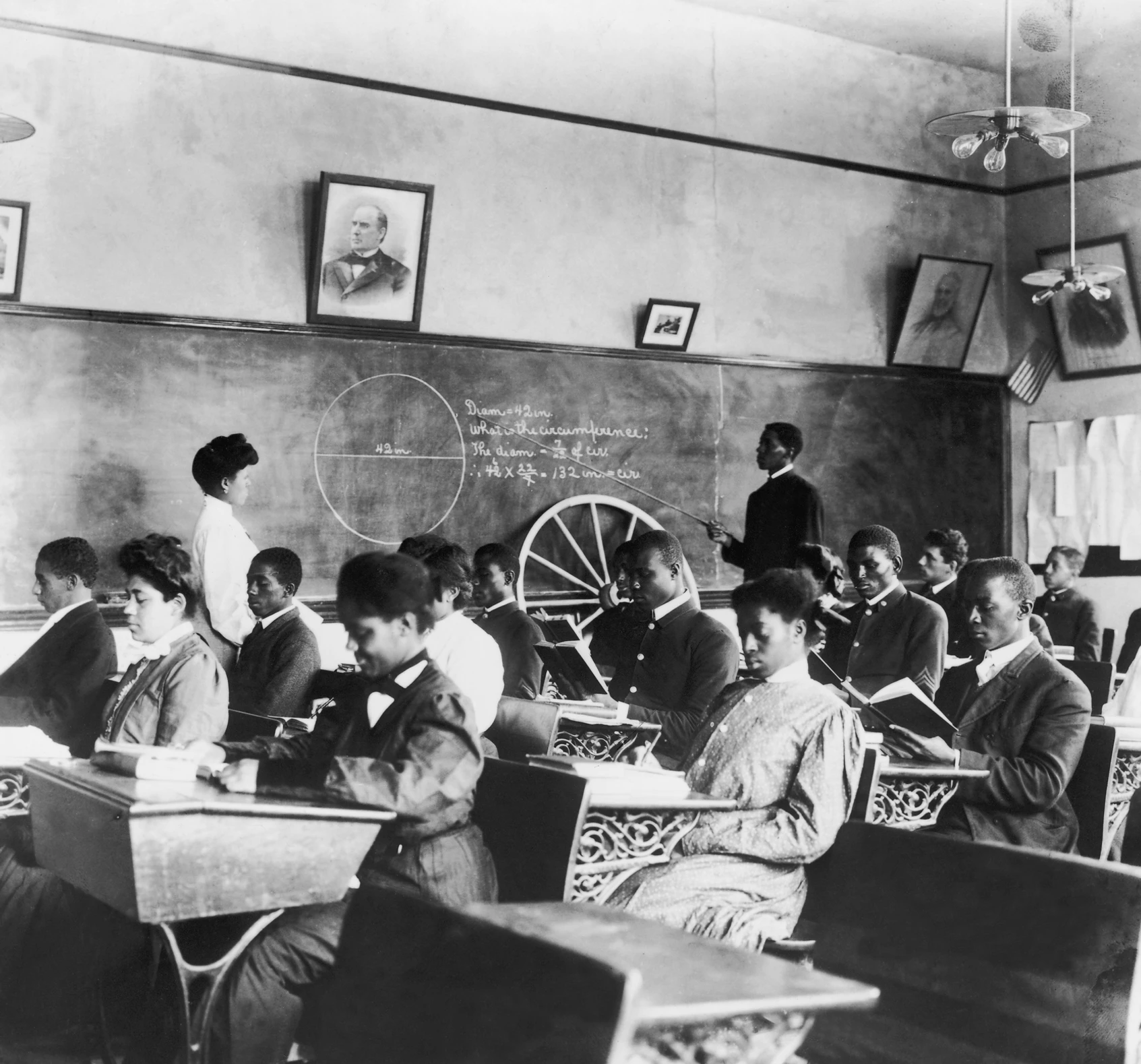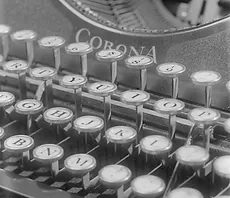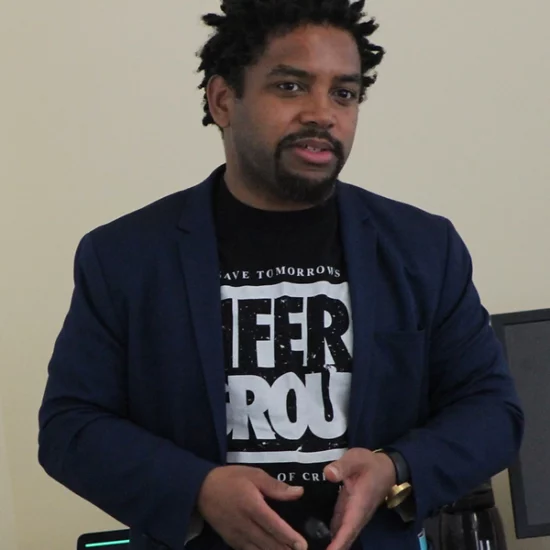Photo by Archive Photos/Stringer/Getty Images
During the early twentieth century, the Tuskegee Institute was harshly criticized by many African American scholars and activists, most famously W. E. B. DuBois, as being an anti-intellectual learning environment that trained students in the same manual labor skills that had been forced on them during enslavement.
That critique became the conventional wisdom. But this photograph, which depicts Tuskegee’s intersection of manual labor informed by specialized intellectual knowledge, complicates that perception.
During a math class at the Tuskegee Institute in 1906, a circle 42 inches in diameter has been drawn on the chalkboard. Its dimensions come from the wagon wheel that is leaning against the wall. That wheel is being used as an object lesson because Tuskegee’s curriculum operates on a pedagogic theory of “correlation.”
Mathematical equations—such as the geometrical relationships to determine the circumference of a circle—were taught in the context of their practical use in daily life rather than as abstract concepts learned in isolation.
For much the same reason that the alphabet is taught as a song—because it helps the brain remember and creates a material association with the letters—the technique of correlation is an example of Booker T. Washington’s concept of “head and hands together.”
The method more familiar in the twenty-first century for teaching the calculation of the circumference of a circle is to use the equation C = π(d). In this math class, instead of writing the Greek symbol π (pi), they use the fraction 22/7, which equals 3.14285714286. When that number is rounded down to 3.14, as is commonly used for π today, the answer yielded by this alternate form of the equation still holds true to the arithmetic laws of geometry.

Photo by Archive Photos/Stringer/Getty Images
In the third line on the chalkboard the diameter is written as being equal to 7/22 of the circumference. That fraction is another way of writing π. The three dots at the beginning of the fourth line are a shorthand symbol for the word “therefore.” The students know that the carriage wheel’s diameter is 42 inches, and the teacher has informed them that the diameter is equal to the circumference times 7/22; therefore, they can multiply 42 inches by 22/7. The answer to this math problem is that the wagon wheel has a circumference of 132 inches (or 11 feet).
Use of the 22/7 fraction to represent π was first created by the ancient Greek mathematician and engineer, Archimedes, in the 3rd century BCE. It likely became part of Tuskegee’s curriculum via a system of manual training called Sloyd, founded in Sweden in the mid-1800s on the classic principles of geometry.
In the 1890s, industrial training schools in the U.S. started incorporating Sloyd into their curriculum. Sloyd’s creators pictured the system’s role in mathematics education as building a road between the brain and the fingers. In the decades before and after this photo was taken, members of Tuskegee’s science faculty traveled to Northern Europe to study the method.
In 1907, Dudley W. Woodard, one of the first African Americans to receive a Ph.D. in Mathematics, was appointed to lead Tuskegee’s mathematics curriculum. In his 1911 book Practical Arithmetic (Tuskegee Institute Edition), he explains how the educational theory of correlation is represented in this photograph.
“The diameter of the front wheels of a wagon made in the Institute Shops was 42 [inches]. … In the Blacksmith Shop iron tires are put on the wheels of the vehicles built in the Institute Shops. In estimating, the amount of iron required for the tire of a wheel, it is necessary to find the circumference of a circle … [which] is found by multiplying the diameter by 3 1/7.”

Photo by Bettmann Collection/Getty Images
The goal of Woodard’s lesson is to teach the students how to “find the cost of the iron used in making the four tires” before they set to work, as pictured in this photo of students in the Tuskegee wheelwright shop from the same period. The correlation theory framed how applied mathematics was taught in the Tuskegee classroom.
In the history of western and eastern culture, respect for geometry has been considered an indicator of advanced civilization. In his book Working with the Hands, Booker T. Washington argued that “there is a vast difference between working and being worked. Being worked means degradation; working means civilization.”
This photograph illustrates Washington’s contribution, as it was described by his secretary and biographer Emmett J. Scott, as a “builder of a civilization.”

Listen to the author:
Learn more:
Woodard, D. W. (Dudley Weldon)., Tuskegee Normal and Industrial Institute. Practical
Arithmetic. Tuskegee Institute edition. Tuskegee Institute, Ala.: Tuskegee Normal &
Industrial Institute. 1911.
Scott, Emmett J. (Emmett Jay), and Lyman Beecher Stowe. Booker T. Washington, Builder of a Civilization. Garden City, N.Y: Doubleday, Page, 1916.
Beckmann, Petr. A History of π (pi). 2d ed. New York: St. Martin’s Press, 1971.





